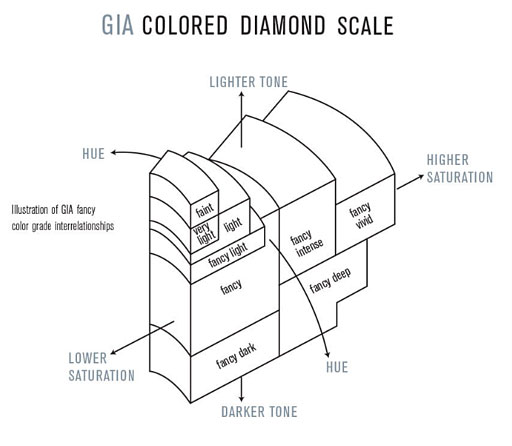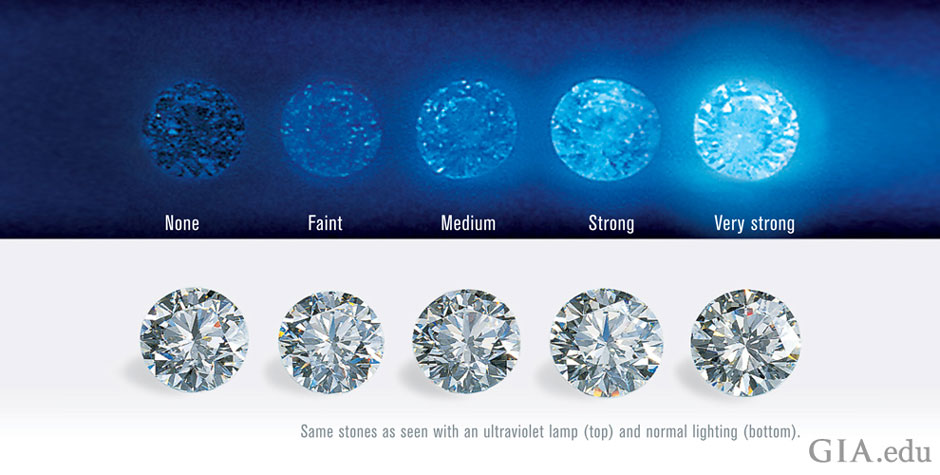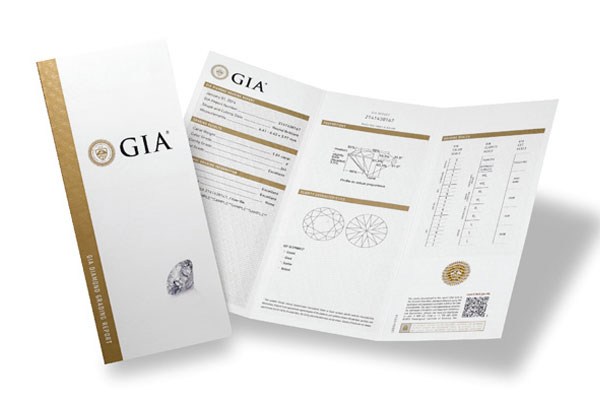Most people know that diamonds are expensive but how do you value a diamond?
If you are wondering that, then this guide is perfect for you as I will go through all the steps that are required to accurately value a diamond.
Now most guides will primarily focus on the 4 C’s but there are other things you need to consider when valuing a Diamond and I will list all of these in this guide.
- Step 1: Make Sure it is a Diamond
- Step 2: Natural or Lab-created?
- Step 3: Check for Treatments
- Step 4: Colour Grading
- Step 5: Clarity Grading
- Step 6: Cut Quality
- Step 7: Weigh the Diamond (Carat)
- Step 7: Check for Fluorescence
- Step 8: Check the Price of the Diamond
- Step 9: Lab Reports (Certificates)
- Conclusion
Step 1: Make Sure it is a Diamond
The very first step in valuing a Diamond is to make sure that it is actually a Diamond!
Sounds pretty obvious but many people including professionals such as jewellers and pawnbrokers have been caught out on this one.
Most people will also head straight for a ‘Diamond tester’, which is an electronic probe that checks the thermal conductivity of the stone (Diamond testers were designed to differentiate between Diamonds and Cubic Zirconia as Diamonds conduct heat but CZ’s don’t).
They may also use a Moissanite tester, which checks for electrical conductivity as diamonds are inert (except for rare natural blue stones coloured by boron) and Moissanite conducts electricity.
The problem is that these testers aren’t 100% reliable and things like humidity and temperature can affect the results.
The best option is to use a 10x loupe and normal observation as there are tell-tale signs when comparing a diamond to other stones. If you want to learn more about this, I have written a separate post which looks at how to tell if a Diamond is real.
Once you have identified that the stone is in fact a Diamond, then you can move on to stage two of the valuation process.
Step 2: Natural or Lab-created?
Now that you know you have a Diamond, it is time to determine the origin of the stone, not where it came from but whether it is a natural or man-made Diamond as this will have a big impact on the price of the stone.
This is because natural Diamond prices are considerably higher than the price of man-made or lab grown Diamonds.
To do this, you are going to need some advanced equipment as most man-made Diamonds will look the same as their natural equivalents. Fortunately, this type of equipment is becoming more and more cost effective and I will list some of the options below:
- SYNTHdetect – $18,000 (approx)
- Yehuda Sherlock Holmes – $6,495
- GemPen £2,000 – £2,500
- Gemetrix Jewellery Inspector – $650
These machines use a combination of LWUV, SWUV to check the fluorescence and phosphorescence of the Diamond to help you determine whether the Diamond is natural or man-made.
Step 3: Check for Treatments
The third step is to check the stone for any treatments, this is because they can effect the grades given to Diamonds when assessing the 4 C’s.
There are two main types of treatment done to Diamonds:
Clarity Enhancement
Clarity enhancements are designed to improve the appearance of fractures or inclusions within a Diamond.
The first type of clarity enhancement is fracture filling, this is where high lead content glass is sucked into surface reaching fractures using a vacuum. This reduces the appearance of the fracture to the naked eye because the refractive index of the glass is close to that of the host diamond material.
Fracture filling can be identified by colour flashes that appear within the fractures of the stone, when the stone is rotated. Common colour flashes includes blue, pink, purple, green and yellow. Due to fracture filling not being a permanent treatment, fracture filled stones can’t be clarity graded.


Another popular form of clarity enhancement is laser drilling, where they drill down to a noticeable inclusion (usually through the crown or table of the Diamond) and then use acids to remove the inclusion.
This is a permanent treatment and does allow for the stone to be clarity graded but another inclusion (the drill channel) has been added to the stone and will usually result in the clarity grade not improving, just the visual appearance when looking down through the top of the stone.
Checking for clarity enhancements can easily be done using a 10x loupe.
Colour Treatments
Diamond can also be treated to improve their colour and these can range from simple, easy to detect treatments such as coating the girdle or pavilion of the stone to more advanced treatments such as Irradiation and Annealing or HPHT (high pressure, high temperature), which requires lab testing to detect.
When you are looking to buy a diamond, one of the things you will undoubtedly come across is the 4 C’s, but what are they and what do they mean?
Step 4: Colour Grading
Now that we know what kind of Diamond we have, it is time to start assessing the quality of it and this is where the 4 C’s do start to come into play but there are additional things to consider, which I will cover below.
A good place to start is with colour grading as this can have a big impact on the value of a Diamond. When it comes to colour grading, we are checking the body colour of the Diamond and to do this accurately, we need to:
- Be in a controlled environment
- Use master stones to compare to the Diamond being assessed
- Use a colour grading tray (usually made from white card or plastic) to provide a neutral background
- Look through the side of the stone, about a 1/3rd of the way between the girdle and culet gives a good representation of the body colour (on elongated cuts such as Emerald or Oval, you want to look down the length of the stone not the width)
This will allow you to as accurately as possible grade the colour of the Diamond and when it comes to colour scales, the GIA scale as shown in the image above is the most commonly used but there is also a very popular colour grading scale by CIBJO.
In terms of value, ‘white’ stones that are D, E or F in colour will be the most valuable, followed by G and H coloured stones and the further you move down the scale, the more the value decreases.
Coloured Diamonds
If the Diamond has a hint of any other colour such as blue, pink or green then a different colour grading system is used.

The diagram above is how GIA grade fancy colours and they look at a combination of the following:
- Hue – which is the general appearance of the colour, for example blue or pink. There may be more than one hue present and you may seen greensih blue on a report, the last colour mentioned is the strongest body colour seen in the diamond and the preceding colours are weaker hues that are visible.
- Tone – describes how light or dark the colour is.
- Saturation – describes how strong the colour seen is, from faint to vivid.
Value of coloured Diamonds can vary greatly with Black and Brown usually being the least valuable and Pink, Blue and especially Reds being the most valuable, fancy, fancy intense or fancy vivid are also more valuable as the stone possesses a strong, beautiful colour that is not too light or dark.
Step 5: Clarity Grading
Next up is clarity grading, which also have a big impact on the value of a Diamond and to clarity grade a Diamond, we:
- Use 10x magnification, can be a loupe of microscope
- Look through the table and crown of the Diamond
- Rotate the Diamond 90 degrees in the tweezers holding the stone
While clarity grading is done on what you can see through the table/crown of the stone, it can be useful to just have a quick look through the pavilion of the stone and if you notice any inclusions, make a note of their location and see if they can then be seen through the table/crown.
As with the colour grading, the most commonly used clarity grading chart is from the GIA and you can see a breakdown of these grades below but there is also one from CIBJO.
- Flawless (F) – diamond is free from any inclusions or blemishes
- Internally Flawless (IF) – diamond is free from any inclusions but has a very small surface blemish
- Very Very Slightly Included (VVS) – There are very very small inclusions within the stone that are very difficult to spot with a 10x loupe
- Very Slightly Included (VS) – Very small inclusions that are difficult to spot with a 10x loupe
- Small Included (SI) – The diamond has small inclusions that are easy to see with a 10x loupe
- Imperfect/Included (I) – The diamond has a easily noticeable inclusions, sometime visible by the naked eye, stone also has beauty and/or durability issues
You may also see a 1 or 2 next to VVS, VS and SI on some diamonds. These are subcategories within the grading criteria and the number and location of inclusions can determine whether it is graded as a 1 or 2. Imperfect diamonds are separated into three subcategories, I1, I2 and I3, the higher the number the more the beauty and durability of the diamond is affected.
Step 6: Cut Quality
The next of the 4 C’s is Cut and while most people (wrongly) assume that we are look at the style of cut but what we are actually looking at is the quality of the cut as this can have a big impact on the appearance of the stone and poorly cut Diamonds can look quite dull and lifeless.

When grading the quality of the cut, there are five grades that can be applied: Poor, Fair, Good, Very Good and Excellent, with triple Excellent or 3x Diamonds attracting the highest price but when assessing the quality of the cut, there are three sub-categories that are looked, which are:
- Proportions – this is the dimensions of the stone and includes the size of the table facet, the angle of the crown and pavilion, the thickness of the girdle and size of the culet
- Symmetry – this is how symmetrical the diamond is and you basically draw a line down the centre of the stone and look at how symmetrical the two sides are
- Polish – this is how good the final polish is on the diamond. If the final polish is not done to a good quality, there will be polishing marks on the stone which do not look very good.
While triple excellent cut Diamonds attract the highest values, it would take an experienced diamond grader to tell the difference between a very good and excellent cut diamond and most gem labs now use 3D scanning to accurately asses the quality of the cut.
Step 7: Weigh the Diamond (Carat)

The final step of the 4 C’s is to weigh the stone and find out the carat weight, for anyone who doesn’t know a Carat is a unit of measurement to weigh gemstones and 1 carat is equal to 0.2 grams. This is done by using calibrated Diamond scales that usually measure to 3 decimal points.
When it comes to carat weight and value, there are certain thresholds or milestones (however you want to phrase it), such as 1ct, 2ct and 5ct that will cause the price of the Diamond to jump, this is because the stone is more desirable. So for example, a 0.98ct diamond will be worth less than a 1.01ct diamond, even though visually you won’t see any difference.
Step 7: Check for Fluorescence

Fluorescence is something that may have already been checked and noted when checking whether the Diamond is natural or man-made but if it hasn’t then it should as strong and very strong fluorescence can have a negative impact on the value of a Diamond.
To check the fluorescence in a Diamond, you need to use Long Wave Ultraviolet light.
Step 8: Check the Price of the Diamond
Now that the quality of the Diamond has been assessed, it is time to check on how much a Diamond of the quality is priced at and for this, the Rapaport Diamond Price list in the industry standard and is released every Thursday.
This price list allows you check the price of Round Brilliant and Pear shaped Diamonds based on their colour, clarity and carat weight, all prices included in the the list are based on the stone having a triple excellent cut.
Once the price has been found for the stone in the price list, research then needs to be done on discounts that are applied to Diamonds and this can be found out by speaking to Diamond dealers, some examples of discounts can be:
- A poorly cut Round Brilliant will have a significant discount over a triple excellent or very good quality cut Diamond
- Fancy cut Diamonds will usually attract a discount over Round Brilliants but it depends on the popularity of that style, so a Cushion Cut will have a much smaller discount than a Heart Cut
Step 9: Lab Reports (Certificates)

The final thing that can impact the value of a Diamond is whether it is accompanied by a report or not as a Diamond without a report will be worth less than an equivalent Diamond with an IGI report but this is worth less than a Diamond with a GIA report.
You will also need to confirm that the report matches the stones and all of the information you gained when assessing and grading the stone will help you confirm if the report does match the stone.
Conclusion
So that is the process that you go through to value a Diamond and if you came here looking for a magic formula, I’m sorry to disappoint!
Knowing how to effectively and accurate grade and value a Diamond takes knowledge and experience and if you don’t possess this yourself, then you should take the Diamond to an independent valuer or appraiser, who will be able to do it for you.
I'm Paul Haywood FGA DGA, a fully qualified Gemmologist and Diamond Grader from the Gemmological Association of Great Britain and a lover of all things jewellery.


